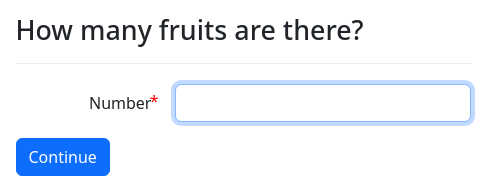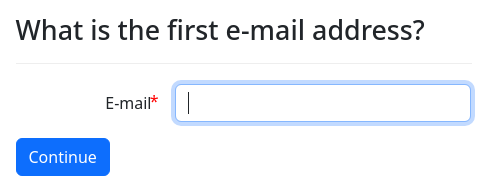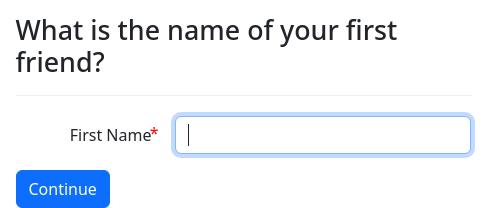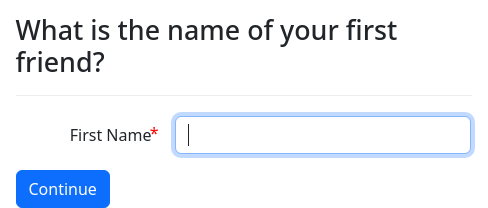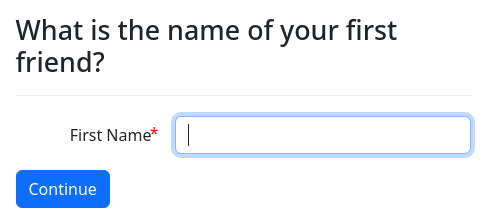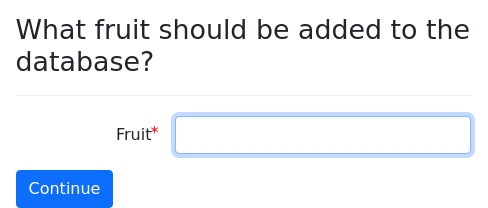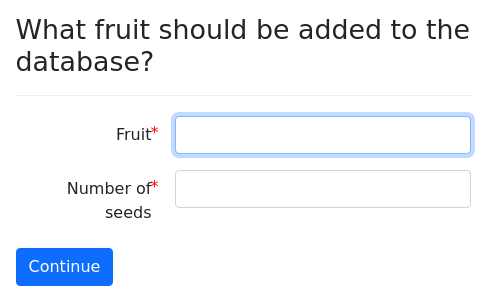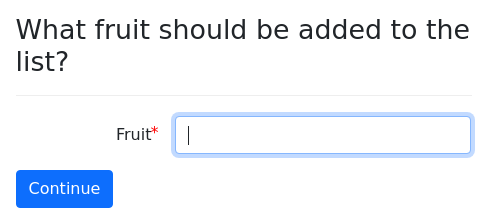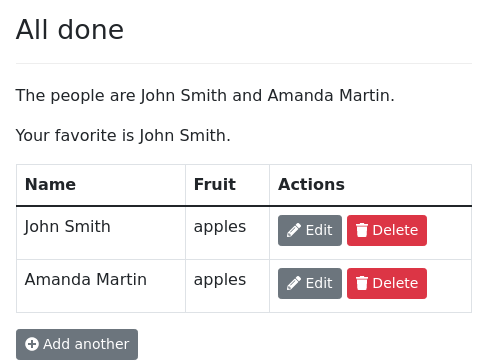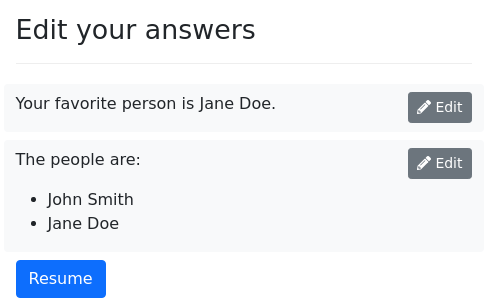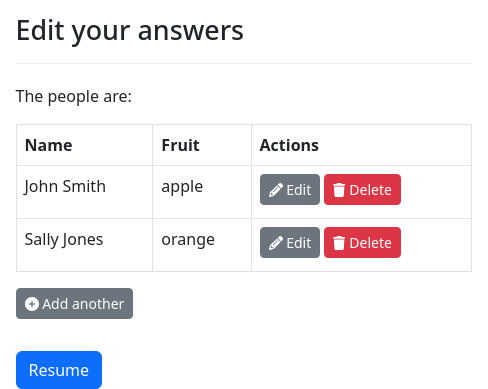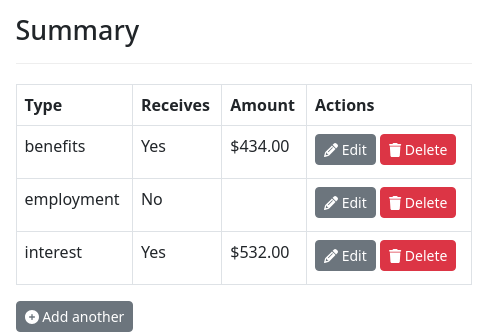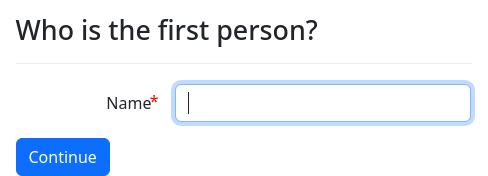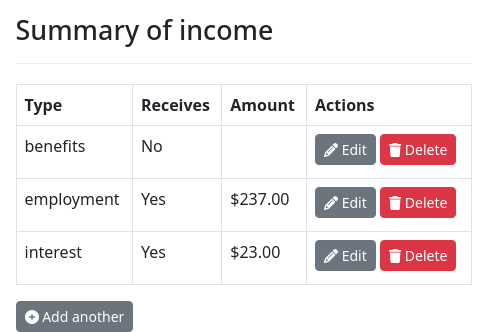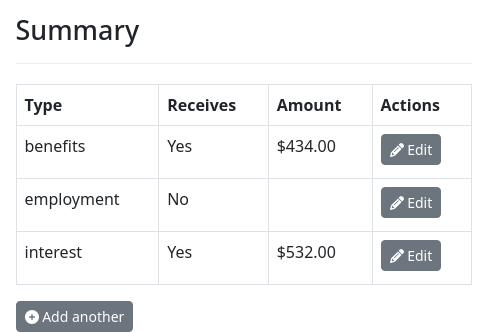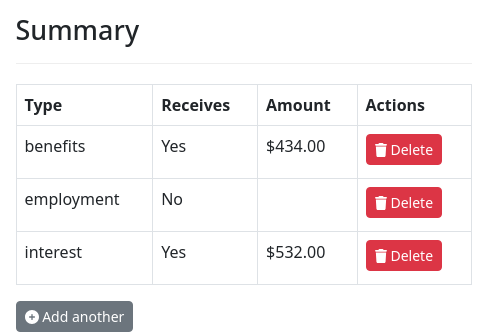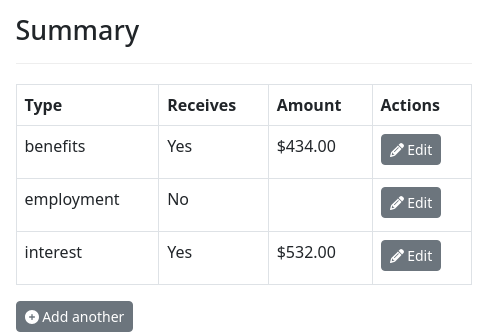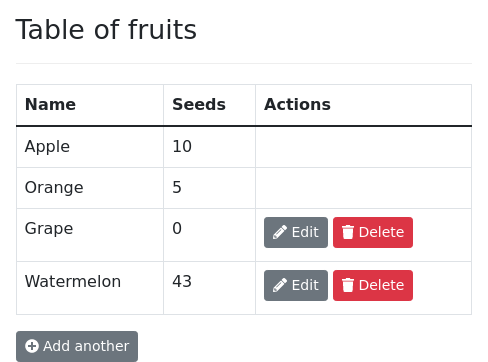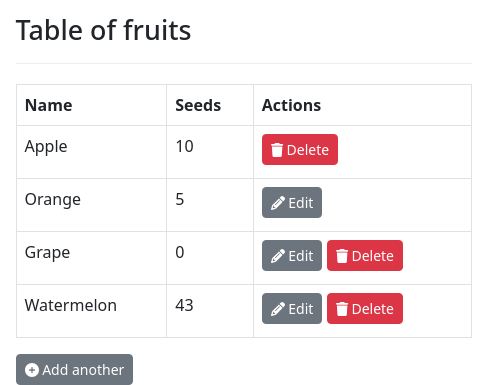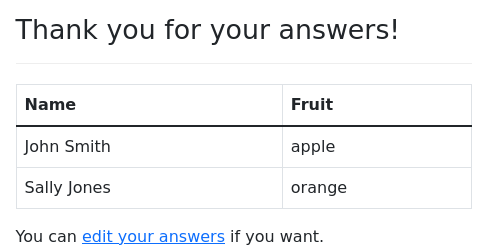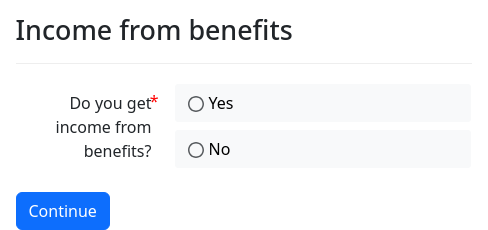To help you organize groups of things, docassemble offers three data structures: lists, dictionaries, and sets. These mirror the list, dict, and set data types that exist in Python.
Overview of types of data structures
Lists in Python
A “list” is a group that has a defined order. Elements are numbered with an index that starts from zero. In Python, if a list is defined as:
fruit = ['apple', 'orange', 'pear']then fruit[0] will return 'apple', fruit[1] will return 'orange',
and fruit[2] will return 'pear'. You can try this out in a
Python interpreter:
>>> fruit = ['apple', 'orange', 'pear']
>>> fruit[0]
'apple'
>>> fruit[1]
'orange'
>>> fruit[2]
'pear'Adding a new element to the list is called “appending” to the list.
>>> fruit = ['apple', 'orange', 'pear']
>>> fruit.append('grape')
>>> fruit
['apple', 'orange', 'pear', 'grape']
>>> sorted(fruit)
['apple', 'grape', 'orange', 'pear']The sorted() function is a built-in Python function that
arranges a list in order.
In docassemble, lists are typically defined as special objects
of type DAList, which behave much like Python lists.
Dictionaries in Python
A “dictionary” is a group of key/value pairs. By analogy with an actual dictionary, the “key” represents the word and the “value” represents the definition. In Python, if a dictionary is defined as:
feet = {'dog': 4, 'human': 2, 'bird': 2}then feet['dog'] will return 4, feet['human'] will return 2,
and feet['bird'] will return 2. The keys are 'dog', 'human', and
'bird', and the values are 4, 2, and 2, respectively.
>>> feet = {'dog': 4, 'human': 2, 'bird': 2}
>>> feet['dog']
4
>>> feet['human']
2
>>> feet['bird']
2
>>> feet.keys()
['dog', 'human', 'bird']
>>> feet.values()
[4, 2, 2]
>>> for key, val in feet.items():
... print("{animal} has {feet} feet".format(animal=key, feet=val))
...
dog has 4 feet
human has 2 feet
bird has 2 feetThe keys of a dictionary are unique. Setting feet['rabbit'] = 4
will add a new entry to the above dictionary, whereas setting
feet['dog'] = 3 will change the existing entry for 'dog'. The
items in a dictionary are “unordered,” so if you want to loop through
them in a particular order, you will need to take special steps to
ensure the items appear in that order, such as keeping a separate
list of the keys in your desired order.
In docassemble, dictionaries are typically objects of type
DADict, which behave much like Python dicts.
Sets in Python
A “set” is a group of unique items with no order. There is no
index or key that allows you to refer to a particular item; an item is
either in the set or is not. (A set in Python behaves much like a set
in mathematical set theory.) In Python, a set can be defined with
a statement like colors = set(['blue', 'red']). Adding a new item to
the set is called “adding,” not “appending.” For example:
colors.add('green'). If you add an item to a set when the item is
already in the set, this will have no effect on the set.
>>> colors = set(['blue', 'green', 'red'])
>>> colors
set(['blue', 'green', 'red'])
>>> colors.add('blue')
>>> colors
set(['blue', 'green', 'red'])
>>> colors.remove('red')
>>> colors
set(['blue', 'green'])In docassemble, sets are typically objects of type DASet,
which behave much like Python sets.
Lists, dictionaries, and sets in docassemble
When you want to gather information from the user into a list,
dictionary, or set, you should use the objects DAList, DADict,
and DASet (or subtypes thereof) instead of Python’s basic
list, dict, and set data types. These objects have special
attributes that help interviews find the right blocks to use to
populate the items of the group.
If you want to, you can use Python’s basic list, dict, and set
data types in your interviews; nothing will stop you – but there are
no special features to help you gather information into these data
structures using question blocks or code blocks.
Gathering information into lists
The following interview populates a list of fruits.
objects:
- fruit: DAList
---
mandatory: True
question: |
There are ${ fruit.number_as_word() }
fruits in all.
subquestion: |
The fruits are ${ fruit }.
---
question: |
Are there any fruit that you would like
to add to the list?
yesno: fruit.there_are_any
---
question: |
What fruit should be added to the list?
fields:
- Fruit: fruit[i]
---
question: |
So far, the fruits include ${ fruit }.
Are there any others?
yesno: fruit.there_is_anotherThe variable fruit is defined as a DAList
object.
objects:
- fruit: DAListAn objects block is like a code block, except that it performs
a special purpose of defining docassemble objects. If
docassemble needs to know the definition of the variable fruit,
it will use this block and initialize fruit as a DAList. (If you
are familiar with Python, you can think of this as a block that runs
fruit = DAList('fruit') where DAList is a Python class.)
The next block contains the end point of the interview, a screen that says how many fruits are in the list and lists them.
mandatory: True
question: |
There are ${ fruit.number_as_word() }
fruits in all.
subquestion: |
The fruits are ${ fruit }.Since this question is mandatory, docassemble tries to ask
it. However, it encounters fruit.number_as_word(), which returns
the number of items in the list (e.g., “two,” “three,” etc.). But in
order to know how many items are in the list, docassemble needs to
ask the user what those items are. So the reference to
fruit.number_as_word() will implicitly trigger the process of asking
questions to gather the list. The reference to ${ fruit } would
also trigger the same process, but docassemble will encounter
fruit.number_as_word() first.
Behind the scenes, when fruit.number_as_word() is run, and
docassemble needs the list to be gathered, it runs
fruit.gather(), a gathering algorithm. The .gather() method
orchestrates the gathering process by triggering the seeking of
variables necessary to gather the list.
Many things other than ${ fruit.number_as_word() will implicitly
trigger the gathering of the fruit list. If you iterate on fruit,
or run a method that uses the items in the list, this will trigger
gathering. The advantage of implicit triggering is that your code can
be concise, and your interview will be parsimonious about whether to
ask questions to gather the list; if you have no code that requires
knowing the items in the list, then the gathering questions will not
be asked. If you want to be explicit about when the list-gathering
questions are asked, you can call fruit.gather() yourself, perhaps
in a mandatory code block.
The gathering algorithm behaves like a lawyer interrogating a witness.
“Do you have any children?” asks the lawyer.
“Yes,” answers the witness.
“What is the name of your first child?”
“James.”
“Besides James, do you have any other children?”
“Yes”
“What is the name of your second child?”
“Charlotte.”
“Besides James and Charlotte, do you have any other children?”
“No”
The .gather() method triggers these questions by seeking the
values of various variables:
fruit.there_are_any: should there be any items in the list at all?fruit[i]: the name of theith fruit in the list.fruit.there_is_another: are there any more fruits that still need to be added?
First, the interview will want to know whether there are any items in
the list at all. It will seek a definition for fruit.there_are_any.
Thus, it will ask the question, “Are there any fruit that you would
like to add to the list?”
question: |
Are there any fruit that you would like
to add to the list?
yesno: fruit.there_are_anyIf the answer to this is True, the interview will seek a definition
for fruit[0] to gather the first element. Thus, it will ask the
question “What fruit should be added to the list?”
question: |
What fruit should be added to the list?
fields:
- Fruit: fruit[i]This question uses the index variable i. The special
variable i means that the question is generalized; it can be used
and re-used for any i (0, 1, 2, 3, etc.). docassemble’s
gathering process automatically takes care of setting the variable i
to the right value before using this question.
Assume the user enters “apples.”
Now docassemble knows the first item in the list, but it does not
know if the list is complete yet. Therefore, it will seek a
definition for fruit.there_is_another. It will ask the question “So
far, the fruits include apples. Are there any others?”
question: |
So far, the fruits include ${ fruit }.
Are there any others?
yesno: fruit.there_is_anotherIf the answer to this is True, the interview will seek a definition
of fruit[1] to gather the second item in the list. It will ask,
again, “What fruit should be added to the list?” Assume the user
enters “oranges.”
Then the interview will again seek the definition of
fruit.there_is_another. This time, if the answer is False, then
the fruit.gather() method will return without asking any questions,
and fruit.number_as_word() will respond with the the number of items
in fruit (in this case, 2). When docassemble later encounters
The fruits are ${ fruit }., it will attempt to reduce the variable
fruit to text. Since the interview knows that there are no more
elements in the list, it does not need to ask any further questions.
${ fruit } will result in apples and oranges.
Note that the variable i is a special variable in
docassemble. When the interview seeks a definition for
fruit[0], the interview will first look for a question that offers
to define fruit[0]. If it does not find one, it will take a more
general approach and look for a question that offers to define
fruit[i]. The question that offers to define fruit[i] will be
reused as many times as necessary.
Since the index variable i is a special variable, you should never
attempt to set it yourself; you will likely get a confusing error if
you try.
Nor should you ever use i in mandatory or initial blocks.
The use of i is reserved for blocks that docassemble calls upon
when it is seeking to define a variable with an index, such as
fruit[2], and there is no block that explicitly defines fruit[2].
If you use i in a mandatory block, you will get an error that
i is undefined, or if i is defined, it might be defined as a value
that makes no sense for the context in which you are using i.
For more information on using variables like i, see the sections on
index variables and how docassemble finds questions for variables.
Customizing the way information is gathered
The way that docassemble asks questions to populate a list like
fruit can be customized by setting attributes of fruit. For
example, perhaps you would prefer that the questions in the interview
go like this:
- How many fruits are there?
- What is the name of the first fruit?
- What is the name of the second fruit?
- etc.
To ask questions this way, set the .ask_number attribute of
fruit to True. Also include a question that asks “How many fruits
are there?” and use fruit.target_number as the variable set by the
question. (The .target_number attribute is a special attribute,
like .there_is_another.)
objects:
- fruit: DAList.using(ask_number=True)
---
question: |
How many fruits are there?
fields:
- Number: fruit.target_number
datatype: integer
min: 2
---
question: |
What is the name of the
${ ordinal(i) } fruit?
subquestion: |
% if fruit.number_gathered() > 0:
So far, you have mentioned ${ fruit }.
% endif
fields:
- Fruit: fruit[i]
---
mandatory: True
question: |
There are ${ fruit.number() }
fruits in all.
subquestion: |
The fruits are ${ fruit }.This example uses the using() method to initialize the
ask_number attribute of fruit. Another way to initialize the
attribute would be to use a mandatory block at the start of the
interview:
mandatory: True
code: |
fruit.ask_number = TrueGenerally, it is best to use the using() method.
You can avoid the .there_are_any
question by setting the .minimum_number to a value:
objects:
- fruit: DAList.using(minimum_number=2)Gathering a list of objects
The examples above have gathered simple variables (e.g., 'apple',
'orange') into a list. You can also gather objects into a list.
You can do this by setting the .object_type of a DAList (or
subtype thereof) to the type of object you want the items of the list
to be.
In this example, we gather Address objects into a DAList by
setting the .object_type attribute to Address.
objects:
- location: |
DAList.using(
object_type=Address,
there_are_any=True)
---
mandatory: True
question: |
The locations
subquestion: |
% for loc in location:
* ${ loc }
% endfor
---
question: |
What is the address of the
${ ordinal(i) } location?
fields:
- Address: location[i].address
- Unit: location[i].unit
required: False
- City: location[i].city
- State: location[i].state
code: |
states_list()
- Zip: location[i].zip
required: False
---
question: |
Would you like to add another location?
yesno: location.there_is_anotherThere are some list types that have an .object_type by default. For
example, DAEmailRecipientList lists have an .object_type of
DAEmailRecipient.
objects:
- recipient: |
DAEmailRecipientList.using(
there_are_any=True)
---
mandatory: True
question: |
The list of recipients
subquestion: |
% for x in recipient:
* ${ x }
% endfor
---
question: |
What is the ${ ordinal(i) } e-mail
address?
fields:
- E-mail: recipient[i].address
datatype: email
---
question: |
Would you like to add another
e-mail recipient?
yesno: recipient.there_is_anotherDuring the gathering process, docassemble only gathers the attributes necessary to display each object as text (by default). So if you do:
objects:
- friend: DAList.using(object_type=Individual)then the list will consist of Individuals, and docassemble
will gather friend[i].name.first for each item in the list. This is
because of the way that the Individual object works: if y is an
Individual, then its textual representation (e.g., including
${ y } in a Mako template, or calling str(y) in Python code) will
run y.name.full(), which, at a minimum, requires a definition for
y.name.first. (See the documentation for Individual for more
details.) Other object types behave differently. For example,
if y is an Address, including ${ y } in a Mako template will
result in y.block(), which depends on the address, city, and
state attributes. If you use a plain DAObject as the
object_type, then no questions will be asked; this is because
the DAObject is meant to be a “base class,” with no meaningful
attributes of its own. Thus, calling str(y) on a plain DAObject
will simply return a name based on the variable name; no questions
will be asked.
If your interview has a list of Individuals and uses attributes of
the Individuals besides the name, docassemble will eventually
gather those additional attributes, but it will ask for the names
first and only when it is done asking for the names of each individual
in the list will it start asking about the other attributes. Here is
an interview that does this:
objects:
- friend: |
DAList.using(
object_type=Individual,
there_are_any=True)
---
mandatory: True
question: |
Your friends
subquestion: |
% for x in friend:
* ${ x } likes
${ noun_plural(x.favorite_animal).lower() }
and is
${ x.age_in_years() }
years old.
% endfor
---
question: |
What is the name of your ${ ordinal(i) }
friend?
fields:
- First Name: friend[i].name.first
---
question: |
What is
${ friend[i].possessive('birthdate') }?
fields:
- Birthdate: friend[i].birthdate
datatype: date
---
question: |
What is
${ friend[i].possessive('favorite animal') }?
fields:
- Favorite animal: friend[i].favorite_animal
---
question: |
Do you have any other friends?
yesno: friend.there_is_anotherThe order of the questions is:
- What is the name of your first friend?
- Do you have any other friends?
- What is the name of your second friend?
- Do you have any other friends?
- What is Fred’s favorite animal?
- What is Fred’s birthdate?
- What is Sally’s favorite animal?
- What is Sally’s birthdate?
If you would prefer that all of the
questions about each individual be asked together, you can use the
.complete_attribute attribute to tell docassemble that an item
is not completely gathered until a particular attribute of that item
(usually .complete) is defined. You can then write a code block
that defines this attribute. You can use this code block to
ensure that all the questions you want to be asked are asked during
the gathering process.
In the above example, we can accomplish this by doing
friend.complete_attribute = 'complete'. Then we include a code
block that sets friend[i].complete = True. This tells
docassemble that an item friend[i] is not fully gathered until
friend[i].complete is defined. Thus, before docassemble moves
on to the next item in a list, it will run this code block to
completion. This code block will cause other attributes of
friend[i] to be defined, including .birthdate and
.favorite_animal. Here is what the revised interview looks like:
objects:
- friend: |
DAList.using(
object_type=Individual,
complete_attribute='complete',
there_are_any=True)
---
mandatory: True
question: |
Your friends
subquestion: |
% for x in friend:
* ${ x } likes
${ noun_plural(x.favorite_animal).lower() }
and is
${ x.age_in_years() }
years old.
% endfor
---
code: |
friend[i].name.first
friend[i].birthdate
friend[i].favorite_animal
friend[i].complete = True
---
question: |
What is the name of your ${ ordinal(i) }
friend?
fields:
- First Name: friend[i].name.first
---
question: |
What is
${ friend[i].possessive('birthdate') }?
fields:
- Birthdate: friend[i].birthdate
datatype: date
---
question: |
What is
${ friend[i].possessive('favorite animal') }?
fields:
- Favorite animal: friend[i].favorite_animal
---
question: |
Do you have any other friends?
yesno: friend.there_is_anotherNow the order of questions is:
- What is the name of your first friend?
- What is Fred’s birthdate?
- What is Fred’s favorite animal?
- Do you have any other friends?
- What is the name of your second friend?
- What is Sally’s birthdate?
- What is Sally’s favorite animal?
- Do you have any other friends?
You can use any attribute you want as the complete_attribute.
Defining a complete_attribute simply means that instead of ensuring
that a list item is displayable (i.e., gathering the name of an
Individual), docassemble will seek a definition of the attribute
indicated by complete_attribute. If .birthdate was the only
element we wanted to define during the gathering process, we could
have written friend.complete_attribute = 'birthdate' and skipped the
code block entirely.
You can also set complete_attribute to a list of attribute names. In
this case, the item will be considered complete when it has a
definition for each attribute in the list of of attributes.
objects:
- friend: |
DAList.using(
object_type=Individual,
complete_attribute=['name.first', 'birthdate', 'favorite_animal'],
there_are_any=True)
---
mandatory: True
question: |
Your friends
subquestion: |
% for x in friend:
* ${ x } likes
${ noun_plural(x.favorite_animal).lower() }
and is
${ x.age_in_years() }
years old.
% endfor
---
question: |
What is the name of your ${ ordinal(i) }
friend?
fields:
- First Name: friend[i].name.first
---
question: |
What is
${ friend[i].possessive('birthdate') }?
fields:
- Birthdate: friend[i].birthdate
datatype: date
---
question: |
What is
${ friend[i].possessive('favorite animal') }?
fields:
- Favorite animal: friend[i].favorite_animal
---
question: |
Do you have any other friends?
yesno: friend.there_is_anotherIt is a best practice to set complete_attribute='complete' and to
specify a code block that sets the .complete attribute of the list
item to True. This will facilitate the use of a table for editing
the list. Every time the user edits a list item in a table, the
.complete attribute will be undefined if complete_attribute is
'complete', and then the definition of .complete will be sought
again. Thus the “completeness” of the list item will always be
recomputed if the user changes something.
When you write your own class definitions, you can set a
default complete_attribute that is not really an attribute, but a method
that behaves like an attribute.
In the following example, FishList is a list of Fish, where a
Fish is considered “complete” for purposes of auto-gathering when
the common_name, scales, and species attributes have been
defined.
from docassemble.base.util import DAList, DAObject
__all__ = ['FishList', 'Fish']
class FishList(DAList):
def init(self, *pargs, **kwargs):
self.object_type = Fish
self.complete_attribute = 'fish_complete'
super().init(*pargs, **kwargs)
class Fish(DAObject):
@property
def fish_complete(self):
self.common_name
self.scales
self.species
def __str__(self):
return self.common_nameHere is an interview that uses this class definition.
modules:
- .fishlist
---
objects:
- fishes: FishList
---
question: |
Are there any fish?
yesno: fishes.there_are_any
---
question: |
Are there any more fish?
yesno: fishes.there_is_another
---
question: |
What is the ${ ordinal(i) } fish's common name?
fields:
- Name: fishes[i].common_name
---
question: |
Tell me more about the ${ fishes[i] }.
fields:
- Species name: fishes[i].species
- Number of scales: fishes[i].scales
datatype: integer
---
mandatory: True
question: |
Thank you for telling me about ${ fishes }.Gathering lists within lists
Here is an example of gathering nested lists (a list within a list within a list).
objects:
- person: |
DAList.using(
object_type=Individual,
minimum_number=1,
complete_attribute='complete')
- person[i].child: |
DAList.using(
object_type=Individual,
complete_attribute='complete')
---
code: |
person[i].name.first
person[i].name.last
person[i].allergy.gather()
person[i].child.gather()
person[i].complete = True
---
code: |
person[i].child[j].name.first
person[i].child[j].name.last
person[i].child[j].allergy.gather()
person[i].child[j].complete = True
---
question: |
What is the name of the
${ ordinal(i) }
person?
fields:
- First: person[i].name.first
- Last: person[i].name.last
---
question: |
Is there another person?
yesno: person.there_is_another
---
question: |
Does ${ person[i] } have any children?
yesno: person[i].child.there_are_any
---
question: |
What is the name of
${ person[i].possessive(ordinal(j) + ' child') }?
fields:
- First: person[i].child[j].name.first
- Last: person[i].child[j].name.last
---
question: |
Does ${ person[i] } have any
children other than ${ person[i].child }?
yesno: person[i].child.there_is_another
---
generic object: Individual
objects:
- x.allergy: DAList
---
generic object: Individual
question: |
Does ${ x } have any allergies?
yesno: x.allergy.there_are_any
---
generic object: Individual
question: |
What allergy does ${ x } have?
fields:
- Allergy: x.allergy[i]
---
generic object: Individual
question: |
Does ${ x } have any allergies
other than ${ x.allergy }?
yesno: x.allergy.there_is_another
---
mandatory: True
question: |
Information retrieved
subquestion: |
You told me about
${ person.quantity_noun('individual') },
their allergies, their children,
and their children's allergies.
% for p in person:
You told me about ${ p }.
% if p.allergy.number() > 0:
${ p } is allergic to ${ p.allergy }.
% endif
% for c in p.child:
${ p } has a child named ${ c }.
% if c.allergy.number() > 0:
${ c } is allergic to ${ c.allergy }.
% endif
% endfor
% endforThe first block defines the objects we will use.
objects:
- person: |
DAList.using(
object_type=Individual,
minimum_number=1,
complete_attribute='complete')
- person[i].child: |
DAList.using(
object_type=Individual,
complete_attribute='complete')(Note that the line breaks here are not meaningful to the syntax; Python allows you to use line breaks in this context for aesthetic reasons.)
The list person will be a list of objects of type Individual.
We assume that there is at least one individual in the list, so we set
minimum_number=1. Since we want to gather more information about
each individual in the list than simply the individual’s name (the
textual representation of an Individual), we set
complete_attribute='complete' to indicate that an individual is not
“complete” until the attribute .complete is defined.
We also assert here that the attribute child for any given person in
the list of people (person[i].child) is a list of Individuals,
each of which will be “complete” when the .complete attribute is
defined. The variable i here is a special variable that is set by
docassemble during the list gathering process. (You should never
try to set i yourself.) If docassemble wants the definition of
person[0].child, it will set i = 0 and then define
person[0].child by running the second line in the objects block.
The next block specifies what it means for an Individual item in
the person list to be “complete.”
code: |
person[i].name.first
person[i].name.last
person[i].allergy.gather()
person[i].child.gather()
person[i].complete = TrueThis says that a given Individual in the person list
(person[i]) is “complete” when the person’s name is defined, when we
have gathered a list of the person;s allergies, and when we have
gathered a list of their children.
We have seen the block that defines person[i].child for any i.
Later on we will see the block that defines person[i].allergy.
When docassemble wants to make a person[0] “complete,” it will
set i = 0 and then run this Python code block. It will keep
running this block until it gets the answers it needs. First it will
ask for the person’s name, then it will go through a list gathering
process to gather the allergies, and then go through a list gathering
process to gather the children, and when there are no more children to
gather, it will define the complete attribute by setting it to
True. Then the person[i] will be “complete,” and docassemble
will continue gathering the person list.
The next block defines what it means for a child of a given
person[i] to be complete. It is similar to the previous block,
except the interview doesn’t ask about a child’s children.
code: |
person[i].child[j].name.first
person[i].child[j].name.last
person[i].child[j].allergy.gather()
person[i].child[j].complete = TrueWhile docassemble is running person[i].child.gather(), it will
ask questions to gather the items in person[i].child and to make
each item, such as person[0].child[1] (for the first person’s second
child) “complete.” Since the child attribute is defined with
complete_attribute='complete', docassemble will try to make
person[0].child[1] “complete” by seeking a definition of
person[0].child[1].complete. There is no block in the interview
that offers to define person[0].child[1].complete specifically, but
the code block above offers to define
person[i].child[j].complete for any arbitrary i and j. So
docassemble will set i = 0 and j = 1, and then try running
this code block. The Python code in this block will trigger all
the necessary questions to make the child object “complete.”
It is very important that the code in this code block is in a
separate block from the previous code block. Each code block
represents a separate statement of truth. The first code block
says what it takes to be finished asking questions about a
person[i], and the second code block says what it takes to be
finished asking questions about one of that person’s children.
If you tried to merge this code with the code from the previous block,
then you might get an error about the variable j being undefined.
If docassemble is looking to define an attribute of person[i],
it will define i and then run the block that offers to define the
attribute of person[i]. But if docassemble, in the course of
running a block that defines the attribute of person[i], encounters
the variable j, it will not know what to do with that; it didn’t set
j to anything before running the code block, so j will be
undefined.
While Python is a “procedural” language, the way docassemble
works is more “declarative.” In most cases, your code blocks should
be self-contained declarations about how a single variable should be
defined, even if they cause other variables to be defined as a side
effect. In this example, those single variables are
person[i].complete and person[i].child[j].complete. The blocks
that define these variables will be called upon at multiple times in
your interview for the specific purpose of defining
person[i].complete or person[i].child[j].complete.
The next block is a reusable question.
question: |
What is the name of the
${ ordinal(i) }
person?
fields:
- First: person[i].name.first
- Last: person[i].name.lastThis question will be used for person[0], person[1], and any
other person[i] in the person list. If docassemble wants to
know person[1].name.first, it will set i = 1 and then ask this
question.
The next block is used whenever docassemble wants to know whether there are more items to be added to a list.
question: |
Is there another person?
yesno: person.there_is_anotherThe .gather() method of the DAList class will undefine the
.there_is_another attribute after each item is gathered, and then
re-seek a definition of .there_is_another to figure out if more
items need to be gathered.
The next block asks whether a person in the person list has any
children.
question: |
Does ${ person[i] } have any children?
yesno: person[i].child.there_are_anyThis is the first question that will be asked when docassemble
runs person[i].child.gather().
The next question illustrates the use of two index variables.
question: |
What is the name of
${ person[i].possessive(ordinal(j) + ' child') }?
fields:
- First: person[i].child[j].name.first
- Last: person[i].child[j].name.lastThe use of the index variables i and j mean that if
docassemble wants to find a definition for
person[1].child[2].name.first, it will set i = 1, set j = 2, and
then ask this question.
If you wanted to ask the question a different way for the first person in the list, you could include the following block:
question: |
What is the name of the first person's
${ ordinal(j) } child?
fields:
- First: person[0].child[i].name.first
- Last: person[0].child[i].name.lastHere, the index variable i is used instead of j. docassemble
will only try to ask this question if the variable it seeks begins
with person[0].child. If docassemble is looking to define
person[1].child[0].name.first, it will disregard this question,
because person[0].child[i].name.first doesn’t generalize to
person[1].child[0].name.first.
Likewise, if you wanted to ask the question a different way for the first child, you could include:
question: |
What is the name of
${ person[i].possessive(ordinal(j) + ' first born child') }?
fields:
- First: person[i].child[0].name.first
- Last: person[i].child[0].name.lastThis question offers to define person[i].child[0].name.first for any
i.
You would never have a block that mentions j without also
mentioning i, and you would never have a block that mentions k
without also mentioning j and i. The variable i needs to be
used for the first index variable that is generalizable, and j needs
to be used for the second index variable that is generalizable.
Next is the block that asks whether a person has any more children.
question: |
Does ${ person[i] } have any
children other than ${ person[i].child }?
yesno: person[i].child.there_is_anotherNext we have a series of blocks relating to gathering the allergies of
people. These are similar in functionality to other blocks in this
interview, but they are different because they use the generic
object modifier and the special variable x, which represents the
“generic” object.
generic object: Individual
objects:
- x.allergy: DAList
---
generic object: Individual
question: |
Does ${ x } have any allergies?
yesno: x.allergy.there_are_any
---
generic object: Individual
question: |
What allergy does ${ x } have?
fields:
- Allergy: x.allergy[i]
---
generic object: Individual
question: |
Does ${ x } have any allergies
other than ${ x.allergy }?
yesno: x.allergy.there_is_anotherThe variable x works in a similar way to the way that index
variables like i and j work. If docassemble wants to define
the attribute allergy for an object person[0], and the object is
of type Individual, it can run x = person[0] and then process the
x.allergy: DAList line of the objects block. Likewise, if
docassemble wants to define person[1].child[0].allergy[3], it can
set x = person[1].child[0], set i = 3, and then ask the
question that defines x.allergy[i]. By using the generic
object feature, we save ourselves the trouble of writing separate
questions for gathering the allergies of person[i] and
person[i].child[j].
Finally, we have the single mandatory block of the interview,
which presents to the user all of the information that was gathered
during the interview.
mandatory: True
question: |
Information retrieved
subquestion: |
You told me about
${ person.quantity_noun('individual') },
their allergies, their children,
and their children's allergies.
% for p in person:
You told me about ${ p }.
% if p.allergy.number() > 0:
${ p } is allergic to ${ p.allergy }.
% endif
% for c in p.child:
${ p } has a child named ${ c }.
% if c.allergy.number() > 0:
${ c } is allergic to ${ c.allergy }.
% endif
% endfor
% endforAll of the questions that are asked during the interview are triggered
by the line % for p in person:. In order to iterate through
person, person first needs to be defined. That triggers the use
of the first objects block to define person. Then person
needs to be gathered, because you can’t iterate through a list that
hasn’t been gathered yet. That causes docassemble to gather the
items in person and to make them “complete.” Before any given
person[i] can be “complete,” the person’s name needs to be
collected, the allergies need to be gathered, and the children need to
be gathered. Before a child can be “complete,” the child’s
allergies need to be gathered. All of these questions are triggered
because each time the screen loads, docassemble tries to show the
mandatory question, and each time, it keeps encountering % for p in
person:.
Once person is gathered, the “for” loops all have enough
information, so no further questions needs to be asked.
Note that while the % for, % endfor, % if, and % endif lines
are indented when nested, the actual lines of text are not indented.
This is because indentation in Markdown has a special meaning (in
particular, to indicate that text should be formatted with a
fixed-width font). The indentation of % for, % endfor, % if,
and % endif is not necessary, but it helps make the code more readable.
Note that the line ${ c } is allergic to ${ c.allergy } makes use of
the fact that the textual representation of a DAList is the result
of running the comma_and_list() method on the list. So the
resulting sentence might be “Jane Doe is allergic to shellfish,
peanuts, and dust.”
Mixed object types
If you want to gather a list of objects that are not all the same
object type, you can do so by setting the .ask_object_type attribute
of the list to True providing a block that defines the
.new_object_type attribute of the list.
objects:
- location: |
DAList.using(
there_are_any=True,
ask_object_type=True)
---
mandatory: True
question: |
The locations
subquestion: |
% for loc in location:
* ${ loc }
% endfor
---
question: |
Do you know the full address of the
${ ordinal(location.current_index()) }
location?
buttons:
- Yes:
code: |
location.new_object_type = Address
- No:
code: |
location.new_object_type = City
---
question: |
What is the address of the
${ ordinal(i) } location?
fields:
- Address: location[i].address
- Unit: location[i].unit
required: False
- City: location[i].city
- State: location[i].state
code: |
states_list()
- Zip: location[i].zip
required: False
---
question: |
What is the city of the
${ ordinal(i) } location?
fields:
- City: location[i].city
- State: location[i].state
code: |
states_list()
---
question: |
Would you like to add another location?
yesno: location.there_is_anotherIn this example, we have a list called location, which is a type of
DAList. We have a mandatory code block that
sets location.ask_object_type to True. This instructs
docassemble that location is a list of objects, and that when a
new item is added to the list, docassemble should to look for the
value of location.new_object_type to figure out what type of object
the new item should be. By contrast, the .object_type attribute
instructs docassemble that the object type for every new object
should be the value of .object_type.
Thus, before docassemble adds a new item to the list, it will seek
a definition of location.new_object_type and then the item it adds
to the list will be an object of the type indicated by the value of
location.new_object_type. After each item is added, docassemble
forgets about the value of location.new_object_type, so the
question will be asked again for each item in the list.
There are a few things to note about the question that defines
location.new_object_type.
question: |
Do you know the full address of the
${ ordinal(location.current_index()) }
location?
buttons:
- Yes:
code: |
location.new_object_type = Address
- No:
code: |
location.new_object_type = CityThis a question about an item in a list, but note that we do not have
a variable i to indicate which item it is, since .new_object_type
is an attribute of the list location, not an attribute of the new
object (location[i]). Thus, we have to use the
.current_index() method to obtain the number.
Note also that we are using the method of
embedding a code block within a multiple choice question in order to
set the value of location.new_object_type based on user input. You
might think it would be simpler to just write the following:
question: |
Do you know the full address of the
${ ordinal(location.current_index()) }
location?
field: location.new_object_type
buttons:
- Yes: Address
- No: CityHowever, this would set location.new_object_type to a piece of text
('Address' or 'City'), instead of the object type (Address or
City). Thus, when setting .new_object_type (or .object_type),
make sure to use Python code.
If you don’t want to use a buttons interface, you can use code such
as the following to set the .new_object_type attribute to a Python
class.
question: |
Do you know the full address of the
${ ordinal(location.current_index()) }
location?
fields:
- Type: location.new_object_type_selection
choices:
- I know the full address
- I only know the city
---
code: |
if location.new_object_type_selection == 'I know the full address':
location.new_object_type = Address
else:
location.new_object_type = City
del location.new_object_type_selectionRunning del location.new_object_type_selection causes
location.new_object_type_selection to be undefined. This ensures that
the next time location.new_object_type is sought, the question will
be asked again.
Note that there are two questions that ask about attributes of the list items:
---
question: |
What is the address of the
${ ordinal(i) } location?
fields:
- Address: location[i].address
- Unit: location[i].unit
required: False
- City: location[i].city
- State: location[i].state
code: |
states_list()
- Zip: location[i].zip
required: False
---
question: |
What is the city of the
${ ordinal(i) } location?
fields:
- City: location[i].city
- State: location[i].state
code: |
states_list()
---You might be wondering how docassemble knows which of these two
questions to ask for a given item in the location list. If the
object is a City, a textual representation of the object will first
ask for .city and then .state. If the object is an Address, a
textual representation of the object will first ask for .address.
When docassemble gathers items into a list, it asks whatever
questions are necessary to construct a textual representation of the
item. So if the attribute docassemble needs is .city, both
questions are capable of defining that attribute. The “What is the
city” question comes last in the YAML file, so it takes precedence
over the “What is the address” question, and it will be asked. If the
attribute docassemble needs is .address, only the “What is the
address” question is capable of defining that, so only that question
will be asked.
If you set .ask_object_type to True and you want docassemble
to query for the .new_object_type, you need to trigger the list
gathering process by directly or indirectly calling .gather() on the
list. If you try to bypass the list gathering process, you may
encounter problems. For example, this will result in an error:
objects:
- mylist: DAlist.using(ask_object_type=True, there_are_any=True)
---
mandatory: True
code: |
mylist[0].favorite_fruitInstead, make sure the interview logic triggers the list gathering process. For example:
objects:
- mylist: DAlist.using(ask_object_type=True, there_are_any=True)
---
mandatory: True
code: |
for item in mylist:
item.favorite_fruitGathering information into dictionaries
The process of gathering the items in a DADict dictionary is
slightly different from the process of gathering the items of a
DAList. Like the gathering process for DAList objects, the
gathering process for DADict objects will call upon the attributes
.there_are_any and .there_is_another.
In addition, the process will look for the attribute .new_item_name
to get the key to be added to the dictionary. In the example below,
we build a DADict in which the keys are the names of fruits and
the values are the number of seeds that fruit contains. There is one
question that asks for the fruit name (fruit.new_item_name) and a
separate question that asks for the number of seeds (fruit[i]).
(When populating a DADict, i refers to the key, whereas when
populating a DAList, i refers to a number like 0, 1, 2, etc.)
objects:
- fruit: DADict
---
mandatory: True
question: |
There
${ fruit.does_verb("is") }
${ fruit.number_as_word() }
fruits in all.
subquestion: |
% for item in fruit:
The fruit ${ item } has
${ fruit[item] } seeds.
% endfor
---
code: |
fruit.there_are_any = True
---
question: |
What fruit should be added to
the database?
fields:
- Fruit: fruit.new_item_name
---
question: |
How many seeds does
${ indefinite_article(noun_singular(i)) }
have?
fields:
- Number of seeds: fruit[i]
datatype: integer
min: 0
---
question: |
So far, the fruits in the database
include ${ fruit }. Are there
any others?
yesno: fruit.there_is_anotherAlternatively, you can use the attribute .new_item_value to set the
value of a new item.
objects:
- fruit: DADict
---
mandatory: True
question: |
There are ${ fruit.number_as_word() }
fruits in all.
subquestion: |
% for item in fruit:
The fruit ${ item } has
${ fruit[item] } seeds.
% endfor
---
code: |
fruit.there_are_any = True
---
question: |
What fruit should be added to
the database?
fields:
- Fruit: fruit.new_item_name
- Number of seeds: fruit.new_item_value
datatype: integer
min: 0
---
question: |
So far, the fruits in the database
include ${ fruit }. Are there
any others?
yesno: fruit.there_is_anotherThe value of the .new_item_value attribute will never be sought by
the gathering process; only the value of the
.new_item_name attribute will be sought. So if you want to use
.new_item_value, you need to set it using a question that
simultaneously sets .new_item_name, as in the example above.
Gathering a dictionary of objects
You can also populate the contents of a DADict in which each value
is itself an object.
objects:
- pet: DADict.using(object_type=DAObject)
---
mandatory: True
question: |
You have ${ pet.number_as_word() }
pets.
subquestion: |
% for item in pet:
Your pet ${ item } named
${ pet[item].name } has
${ pet[item].feet } feet.
% endfor
---
question: |
Do you have any pets?
yesno: pet.there_are_any
---
question: |
What kind of pet do you have?
fields:
- Type of pet: pet.new_item_name
---
question: |
Describe your pet ${ i }.
fields:
- Name: pet[i].name
- Number of feet: pet[i].feet
datatype: integer
min: 0
---
question: |
So far, you have told me about your
${ pet }. Do you have any other
pets?
yesno: pet.there_is_anotherIn the example above, we populate a DADict called pet, in which
the keys are a type of pet (e.g., 'cat', 'dog'), and the values
are objects of type DAObject with attributes .name (e.g.,
'Mittens', 'Spot') and .feet (e.g., 4). We need to start by
telling docassemble that the DADict is a dictionary of
objects. We do this by setting the .object_type attribute of the
DADict to DAObject. Then we provide a question that sets the
.new_item_name attribute.
When a .object_type is provided, docassemble will take care of
initializing the value of each entry as an object of this type. It
will also automatically gather whatever attributes, if any, are
necessary to represent the object as text. The representation of the
object as text is what you see if you include the object in a Mako template:
${ pet['cat'] }. (Or, if you know Python, it is the result of
str(pet['cat']).) The attributes necessary to represent the object
as text depend on the type of object. In the case of a DAObject,
no attributes are required to represent the object as text. In the
case of an Individual, the individual’s name is required
(.name.first at a minimum).
Since a DAObject does not have any necessary attributes, then in
the example above, the pet object is considered “gathered”
(i.e. pet.gathered is True) after all the types of pet (e.g.,
'cat', 'dog') have been provided. At this point, the values of
the DADict are simply empty DAObjects. The .name and
.feet attributes are still not defined. The final screen of the
interview, which contains a “for” loop that describes the number of
feet of each pet, causes the asking of questions to obtain the .feet
and .name attributes.
Gathering information into sets
The gathering of items into a DASet is much like the gathering of
items into a DADict. The difference is that instead of using the
attributes .new_item_name and .new_item_value, you use a single
attribute, .new_item.
Here is an example that gathers a set of text items (e.g., 'apple',
'orange', 'banana') into a DASet.
objects:
- fruit: DASet
---
mandatory: True
question: |
There are ${ fruit.number_as_word() }
fruits in all.
subquestion: |
The fruit include ${ fruit }.
---
question: |
Should there be any fruits
in the set?
yesno: fruit.there_are_any
---
question: |
What fruit should be added to
the set?
fields:
- Fruit: fruit.new_item
---
question: |
So far, the fruits in the set
include ${ fruit }. Are there
any others?
yesno: fruit.there_is_anotherYou can also gather objects into a DASet. However, the DASet
does not use the .object_type attribute, as DAList and
DADict groups do. The objects that you gather into a DASet
need to exist already.
In the example below, we create several DAObjects, each
representing a fruit, and we use a multiple choice question with
datatype set to object to ask which fruits the user likes. (See
selecting objects for more information about these types of
questions.)
objects:
- fruit: DASet
- my_favorites: DASet
- apple: DAObject
- orange: DAObject
- pear: DAObject
- plum: DAObject
- grape: DAObject
---
mandatory: True
code: |
apple.name = "apples"
orange.name = "oranges"
pear.name = "pears"
plum.name = "plums"
grape.name = "grapes"
my_favorites.add(apple, pear)
my_favorites.gathered = True
---
mandatory: True
question: |
There are ${ fruit.number_as_word() }
fruits in all.
subquestion: |
% if fruit.number():
The fruits you like include ${ fruit }.
% endif
% if fruits_in_common.number():
The fruits we both like are
${ fruits_in_common }.
% endif
---
code: |
fruits_in_common = fruit.intersection(my_favorites)
---
question: |
Do you like ${ apple }, ${ orange },
${ pear }, ${ plum }, or ${ grape }?
yesno: fruit.there_are_any
---
question: |
Pick a fruit that you like.
fields:
- Fruit: fruit.new_item
datatype: object
choices:
- apple
- orange
- pear
- plum
- grape
---
question: |
So far, you have indicated you like
${ fruit }. Are there any other
fruits you like?
yesno: fruit.there_is_anotherManually triggering the gathering process
In the examples above, the process of asking questions that populate
the list is triggered implicitly by code like ${ fruit.number() },
${ fruit } or % for item in fruit:.
If you want to ask the questions at a particular time, you can do so
by referring to fruit.gather(). (Behind the scenes, this is the
same method used when the process is implicitly triggered.)
mandatory: True
code: |
fruit.gather(minimum=1)
---
question: |
What fruit should be added to the list?
fields:
- Fruit: fruit[i]
---
question: |
So far, the fruits include
${ fruit }. Are there any others?
yesno: fruit.there_is_another
---
mandatory: True
question: |
The fruits are ${ fruit }.The .gather() method accepts some optional keyword arguments:
minimumcan be set to the minimum number of items you want to gather. The.there_are_anyattribute will not be sought. The.there_is_anotherattribute will be sought after this minimum number is reached.numbercan be set to the total number of items you want to gather. The.there_is_anotherattribute will not be sought.item_object_typecan be set to the type of object each element of the group should be. (This is not available forDASetobjects.)complete_attributecan be set to the name of an attribute that should be sought for each item during the gathering process. You can also set thecomplete_attributeattribute of the group object itself.
The .gather() method is not the only way that a gathering process
can be triggered. The .auto_gather attribute controls whether the
.gather() method is invoked. If .auto_gather is True (which is
the default), then the gathering process will be triggered using
.gather(). If .auto_gather is False, the gathering process will
be triggered in a simpler way: by seeking the value of .gathered.
Thus, you can provide a code block that sets .gathered to
True. For example:
code: |
fruit.append('apple', 'orange', 'grape')
fruit.gathered = True
---
mandatory: True
code: |
fruit.auto_gather = False
---
mandatory: True
question: |
The fruits are ${ fruit }.Setting .gathered to True means that when you try to get the
length of the group or iterate through it, docassemble will assume
that nothing more needs to be done to populate the items in the group.
You can still add more items to the list if you want to, using
code blocks.
Detailed explanation of gathering process
At a very basic level, it is not complicated to gather a list of things from a user. For example, you can do this:
objects:
- fruit: DAList
---
question: |
How many fruits are there?
fields:
- Number: number_of_fruits
datatype: integer
min: 2
---
question: |
What's the ${ ordinal(i) } fruit?
fields:
- Fruit: fruit[i]
---
mandatory: True
question: |
Fruits
subquestion: |
The fruits are:
% for index in range(0, number_of_fruits):
* ${ fruit[index] }
% endforThis example uses Python’s built-in range() function, which
returns a list of integers starting with the first argument and less
than the second argument. For example:
>>> range(0, 5)
[0, 1, 2, 3, 4]The for loop iterates through all the numbers using the variable
index, looking for fruit[index]. The first item it looks for is
fruit[0]. Since this is not defined yet, the interview looks for a
question that offers to define fruit[0]. It does not find any
questions that define fruit[0], so it then looks for a question that
offers to defined fruit[i]. It finds this question, and asks it of
the user. After the user provides an answer, the for loop runs
again. This time, fruit[0] is already defined. But on the next
iteration of the for loop, the interview looks for fruit[1] and
finds it is not defined. So the interview repeats the process with
fruit[1]. When all of the fruit[index] are defined, the
mandatory question is able to be shown to the user, and the
interview ends.
Another way to ask questions is to ask for one item at a time, and after each item, ask if any additional items exist.
objects:
- fruit: |
DAList.using(
auto_gather=False,
gathered=True)
comment: |
These attributes disable the automatic
gathering system.
---
mandatory: True
code: |
num_fruits = 0
more_fruits = True
---
mandatory: True
code: |
while more_fruits:
fruit[num_fruits]
num_fruits += 1
del more_fruits
---
question: |
Are there more fruits?
yesno: more_fruits
---
question: |
What's the ${ ordinal(i) } fruit?
fields:
- Fruit: fruit[i]
---
mandatory: True
question: |
Fruits
subquestion: |
The fruits are:
% for item in fruit:
* ${ item }
% endforTo gather the list manually, it is necessary to disable the automatic gathering system:
objects:
- fruit: |
DAList.using(
auto_gather=False,
gathered=True)This example uses a little bit of Python code to ask the appropriate questions.
Some variables are initialized:
num_fruits = 0
more_fruits = TrueThen the main algorithm is:
while more_fruits:
fruit[num_fruits]
num_fruits += 1
del more_fruitsSince more_fruits is initialized as 0, the first undefined
variable that this code encounters is fruit[0]. When the code
encounters fruit[0], it will go looking for the value of fruit[0],
and the question “What’s the first fruit?” will be asked. Once
fruit[0] is defined, the interview undefines more_fruits, but then
when the while loop loops around, the definition of more_fruits is
needed. Since more_fruits is undefined, the interview presents the
user with the more_fruit question, which asks “Are there more
fruits?” If more_fruits is True, the loop repeats, and the
definition of fruit[1] is sought.
This is starting to get complicated. And things get even more complicated when you want to say things like “There are three fruits in all” and “You have told me about three fruits so far” in your interview questions. In the case of “There are three fruits in all,” a prerequisite to saying this is to make sure that the user has supplied the full list. But in the case of “You have told me about three fruits so far,” you would not want this prerequisite.
Since asking users for lists of things can get complicated, docassemble has a feature for automating the process of asking the necessary questions to fully populate the list.
If your list is fruit, there are three special attributes:
fruit.gathered, fruit.there_are_any, and fruit.there_is_another.
The fruit.gathered attribute is initially undefined, but is set to
True when the list is completely populated. The
fruit.there_are_any attribute is used to ask the user whether the
list is empty. The fruit.there_is_another attribute is used to ask
the user questions like “You have told me about three fruits so far:
apples, peaches, and pears. Are there any additional fruits?”
In addition to these two attributes, there is special method,
fruit.gather(), which will cause appropriate questions to be asked
and will return True when the list has been fully populated. The
.gather() method looks for definitions for fruit.there_are any,
fruit[i], and fruit.there_is_another. It makes
fruit.there_is_another undefined as necessary.
Here is a complete example:
objects:
- fruit: DAList
---
mandatory: True
question: |
There are ${ fruit.number_as_word() }
fruits in all.
subquestion: |
The fruits are ${ fruit }.
---
question: |
Are there any fruit that you would like
to add to the list?
yesno: fruit.there_are_any
---
question: |
What fruit should be added to the list?
fields:
- Fruit: fruit[i]
---
question: |
So far, the fruits include ${ fruit }.
Are there any others?
yesno: fruit.there_is_anotherAvoiding triggering the gathering process
docassemble implicitly calls .gather() in many circumstances,
such as when you do for item in my_list:, len(my_list), or
my_dict.items(). In some situations, you may want to use a DAList,
DADict, or DASet while the gathering process is still going on, or
has not been started yet.
To test whether a group has been gathered, you can call
.has_been_gathered() on it. This will return True if the group
has been gathered, and False otherwise.
To test whether the gathering process has been started, you can access
the .gathering_started attribute.
To get the number of items in a group without triggering the gathering
process, call .number_gathered(). This will return the number of
items gathered so far.
To sort a group even if it has not been fully gathered yet, call
.sort_elements() instead of .sort().
The DAList, DADict, and DASet objects have an attribute
.elements that is a plain Python list, dict, or set containing
the items in the group. To bypass the special features of DAList,
DADict, and DASet, you can access .elements directly, and the
list gathering process will not be triggered.
When the gathering process is still going on and your group contains
objects, .elements may contain one or more items that are not
usable. For example, when the interview is in the process of asking
for the fifth item in the group, you may want to show the user the
first four items. However, if you try to loop over .elements and
display information about each one, you may find yourself in a
Catch-22 because your code expects attributes of the fifth item to be
defined when those attributes are defined by the very same
question you are trying to ask. Instead of accessing .elements,
you can call .complete_elements(). This will return a DAList,
DADict, or DASet containing only elements that are “complete.”
Whether an item is “complete” depends on whether the group has a
complete_attribute. If the group has a complete_attribute, an
item in the group will be considered “complete” if the item has an
attribute by the name of the complete_attribute. If the group does
not have a complete_attribute, an item will be considered
“complete” if it can be reduced to text without encountering an
undefined variable. For example, an Individual object can be
reduced to text if the .name.first attribute is defined, so if a
DAList called my_list contains several Individual objects,
my_list.complete_elements() will return a DAList containing a
only those objects where .name.first is defined.
Using “for loops”
In computer programming, a “for loop” allows you to do something repeatedly, such as iterating through each item in a list.
For example, here is an example in Python:
numbers = [5, 7, 2]
total = 0
for n in numbers:
total = total + n
print totalThis code “loops” through the elements of numbers and computes the
total amount. At the end, 14 is printed.
For loops based on DAList, DADict, and DASet objects can
be included in textual content using the for/endfor Mako statement:
code: |
fruit_list = ['peaches', 'pears', 'apricots']
---
question: |
Summary of fruit
subquestion: |
% for fruit in fruit_list:
I assume you like ${ fruit }.
% endfor
mandatory: TrueMako “for” loops work just like Python for loops, except that they need to be ended with “endfor.”
If the list might be empty, you can check its length using an
if/else/endif Mako statement:
question: |
Summary of fruit
subquestion: |
% if len(fruit_list) > 0:
% for fruit in fruit_list:
I assume you like ${ fruit }.
% endfor
% else:
There are no fruits to discuss.
% endif
mandatory: TrueYou can also use the .number() method:
question: |
Summary of the case
subquestion: |
% if case.plaintiff.number() > 0:
% for person in case.plaintiff:
${ person } is a plaintiff.
% endfor
% else:
There are no plaintiffs.
% endifYou can check if something is in a list using a statement of the form
if … in:
---
question: |
% if client in case.plaintiff:
Since you are bringing the case, it will be your responsibility to
prove that you were harmed.
% else:
The responsibility to prove this case belongs to
${ case.plaintiff }. You do not have to testify in your defense.
% endif
---For more information about “for loops” in Mako, see the markup section.
Edit an already-gathered list
It is possible to allow your users to edit a DAList list that has
already been gathered. Here is an example.
mandatory: True
question: |
All done
subquestion: |
The people are ${ person }.
Your favorite is ${ favorite }.
${ person.table }
${ person.add_action() }
---
table: person.table
rows: person
columns:
- Name: |
row_item.name.full()
- Fruit: |
row_item.favorite_fruit
edit:
- name.first
- favorite_fruitThis works using two features:
- The
editspecifier on thetableblock, which adds an “Actions” column to the table and indicates which screens should be shown when the user clicks the “Edit” button. First a screen will be shown that asks for the the attribute.name.first. Then a screen will be shown that asks for the attribute.favorite_fruit. - The
.add_action()method on theDAListinserts HTML for a button that the user can press in order to add an entry to an already-gathered list.
You can allow your users to edit a DAList from an edit button in a
review page.
mandatory: true
question: |
Thank you for your answers!
subquestion: |
The people are ${ person } and your
favorite is ${ favorite }.
You can
[edit your answers](${ url_action('review_interview') })
if you want.
---
event: review_interview
question: |
Edit your answers
review:
- Edit: favorite
button: |
Your favorite person is ${ favorite }.
- Edit: person.revisit
button: |
The people are:
% for y in person:
* ${ y }
% endfor
---
continue button field: person.revisit
question: |
Edit the people
subquestion: |
${ person.table }
${ person.add_action() }
---
table: person.table
rows: person
columns:
- Name: |
row_item.name.full()
- Fruit: |
row_item.favorite_fruit
edit:
- name.first
- favorite_fruitThe attribute .revisit of a DAList is special; it is undefined
by default and is set to True by the auto-gathering process at the
same time that .gathered is set to True. Because .revisit is
undefined at first, the review block will not show the “Edit”
button for the list until the list is gathered. When the list has
been gathered, and the user clicks the “Edit” button associated with
.revisit, the user is taken to the block with continue button field:
person.revisit. On this screen, you can show the list as a table
and provide the .add_action() button if you want users to be able to
add entries.
Putting an editable table directly into a review page is also possible.
need: person.table
mandatory: true
question: |
Thank you for your answers!
subquestion: |
The people are ${ person }.
You can
[edit your answers](${ url_action('review_interview') })
if you want.
---
event: review_interview
question: |
Edit your answers
review:
- note: |
% if len(person):
The people are:
${ person.table }
${ person.add_action() }
% else:
There are no people.
${ person.add_action("I would like to add one.") }
% endif
---
table: person.table
rows: person
columns:
- Name: |
row_item.name.full()
- Fruit: |
row_item.favorite_fruit
edit:
- name.first
- favorite_fruitThe line need: person.table is important here. An item in a
review list will not be shown if it contains any undefined
variables. The presence of an undefined variable in a review list
item will not cause docassemble to seek a definition of that
variable (unless the specifier skip undefined: False is used).
Therefore, if you want a review item containing a table to be
displayed, you need to make sure that the variable representing the
table gets defined by the time that you want the table to be
editable. In this example, need: person.table ensures that the
variable representing the table is defined before the user is given
the opportunity to review his or her answers.
While the above examples have all featured tables for editing DAList
objects, the edit feature can also be used when the rows of the
table refer to a DADict:
objects:
- income: |
DADict.using(
object_type=DAObject,
keys=['employment', 'benefits', 'interest'],
complete_attribute='complete',
there_is_another=False)
---
code: |
if income[i].receives:
income[i].amount
income[i].complete = True
---
question: |
Income from ${ i }
fields:
- "Do you get income from ${ i }?": income[i].receives
datatype: yesnoradio
- "How much do you get from ${ i }?": income[i].amount
datatype: currency
show if: income[i].receives
---
table: income.table
rows: income
columns:
- Type: |
row_index
- Receives: |
'Yes' if row_item.receives else 'No'
- Amount: |
currency(row_item.amount) if row_item.receives else ''
edit:
- receivesIf your DAList is not made up of objects, it can be made editable
by setting edit to True instead of to a list of attributes.
question: |
Who is the ${ ordinal(i) } person?
fields:
- Name: person[i]
---
question: |
Are there any more people
you would like to mention?
yesno: person.there_is_another
---
mandatory: True
question: |
All done
subquestion: |
The people are ${ person }.
${ person.table }
${ person.add_action() }
---
table: person.table
rows: person
columns:
- "#": |
row_index + 1
- Name: |
row_item
edit: TrueYou can do the same with DADict groups that do not use objects:
question: |
Income from ${ i }
fields:
- "How much income do you get from ${ i }?": income[i]
datatype: currency
---
question: |
What type of income would you
like to add?
fields:
- "Type of income": income.new_item_name
---
table: income.table
rows: income
columns:
- Type: |
row_index
- Receives: |
'Yes' if row_item > 0 else 'No'
- Amount: |
currency(row_item) if row_item > 0 else ''
edit: TrueCustomizing the editing interface
If you do not want your users to be able to delete items, you can add
delete buttons: False to the table.
table: income.table
rows: income
columns:
- Type: |
row_index
- Receives: |
'Yes' if row_item.receives else 'No'
- Amount: |
currency(row_item.amount) if row_item.receives else ''
edit:
- receives
delete buttons: FalseOr, if you want your users to be able to delete items, but not edit
items, you can include delete buttons: True and do not include
edit:
table: income.table
rows: income
columns:
- Type: |
row_index
- Receives: |
'Yes' if row_item.receives else 'No'
- Amount: |
currency(row_item.amount) if row_item.receives else ''
delete buttons: TrueIf you want to allow your users to delete items, but only if the group
is longer than a certain length, you can give the DAList or
DADict a minimum_number attribute.
objects:
- income: |
DADict.using(
object_type=DAObject,
keys=['employment', 'benefits', 'interest'],
complete_attribute='complete',
minimum_number=3,
there_is_another=False)If you have a DAList or a DADict and you
want the user to confirm before deleting an item that they really
meant to delete the item, you can include confirm: True.
table: income.table
rows: income
columns:
- Type: |
row_index
- Receives: |
'Yes' if row_item.receives else 'No'
- Amount: |
currency(row_item.amount) if row_item.receives else ''
delete buttons: True
confirm: TrueIf you want specific items to be protected
against editing and/or deletion, you can set a read only specifier:
mandatory: True
code: |
fruit.appendObject()
fruit[-1].important = True
fruit[-1].name.text = 'Apple'
fruit[-1].seeds = 10
fruit.appendObject()
fruit[-1].important = True
fruit[-1].name.text = 'Orange'
fruit[-1].seeds = 5
---
code: |
fruit[i].important = False
---
table: fruit.table
rows: fruit
columns:
- Name: |
row_item
- Seeds: |
row_item.seeds
edit:
- name.text
read only: importantIn this example, the attribute important of the table fruit
determines whether the item is “read only” or not. The first two
items in the DAList, which are added to the list in a code block,
have the important attribute set to True, while items that are
added by the user have the important attribute set to False.
Since read only is set to important, the Edit and Delete
buttons are not available for the items that have the important
attribute set to True.
If you want to allow editing but not deletion, or vice versa, the
value of the attribute can be set to a Python dictionary rather than
the value True or False. If the value of the key edit is false,
the “Edit” button will not be shown. If the value of the key
delete is false, the “Delete” button will not be shown.
mandatory: True
code: |
fruit.appendObject()
fruit[-1].important = {'delete': True, 'edit': False}
fruit[-1].name.text = 'Apple'
fruit[-1].seeds = 10
fruit.appendObject()
fruit[-1].important = {'delete': False, 'edit': True}
fruit[-1].name.text = 'Orange'
fruit[-1].seeds = 5
---
code: |
fruit[i].important = False
---
table: fruit.table
rows: fruit
columns:
- Name: |
row_item
- Seeds: |
row_item.seeds
edit:
- name.text
read only: importantTypically, the creation of a table
requires the gathering process to be completed. However, if the
gathering process is already ongoing, then the table will still be
created, and it will only contain items that are “complete.” If you
do not want the showing of the table to trigger the gathering
process, set require gathered: False.
If you have a table definition that includes
editable elements (i.e. edit, delete buttons), but you want to
present the table with the editing features in some contexts, but
without the editing features in other contexts, you can include the
table by calling the method .show() with editable=False to hide
the editing features.
mandatory: true
question: |
Thank you for your answers!
subquestion: |
${ person.table.show(editable=False) }
You can
[edit your answers](${ url_action('review_interview') })
if you want.Canceling an add or edit process
If you want to allow the user to cancel the process of adding or
editing the item of a DAList, you can offer the user an “action”
that runs the .cancel_add_or_edit() method on the list.
question: |
What is the name of the ${ ordinal(i) } fruit?
fields:
- Name: fruits[i].name.text
action buttons:
- label: Cancel
action: fruits.cancel
color: secondary
show if: fruits.has_been_gathered()
---
question: |
How many seeds does ${ fruits[i] } have?
fields:
- Seeds: fruits[i].seeds
datatype: integer
action buttons:
- label: Cancel
action: fruits.cancel
color: secondary
show if: fruits.has_been_gathered()
---
event: fruits.cancel
code: |
fruits.cancel_add_or_edit()This will cancel any pending actions related to the list and delete the last item in the list if it is incomplete.
In this example, using show if: fruits.has_been_gathered() was not
required; you may want to use that so that the “Cancel” buttons are
not shown until the list is edited after having been gathered.
Reorder an already-gathered list
If you have a DAList and you want to allow the user to change the
order of items in the list, you can set allow reordering to True:
table: fruit_table
rows: fruit
columns:
- Fruit Name: row_item.name
- Seeds: row_item.seeds
edit:
- name.text
allow reordering: TrueThe changes to the order of elements will be saved when the user presses Continue.
Use a table to gather the list
It is possible to use a table for the initial gathering process, not
just for editing an already-gathered list. You can do this by
initializing the list with gathered=True and then placing something
in the interview logic that forces the user to visit a page with a
table and an .add_action() button.
objects:
- parties: DAList.using(object_type=Individual,
complete_attribute='complete',
gathered=True)
---
code: |
parties[i].name.first
parties[i].role
parties[i].complete = True
---
question: |
Parties to the case
subquestion: |
% if parties.number() > 0:
${ parties.table }
${ parties.add_action(label="Add another party") }
% else:
Every case must have at least one party.
${ parties.add_action(label="Add a party") }
% endif
continue button field: parties.reviewed
hide continue button: |
parties.number() == 0
---
table: parties.table
rows: parties
columns:
- Name: row_item
- Role: row_item.role
edit:
- name.first
- role
---
question: |
What is the name of the ${ ordinal(i) } party?
fields:
- First name: parties[i].name.first
- Last name: parties[i].name.last
---
question: |
Is ${ parties[i] } a plaintiff or a defendant?
field: parties[i].role
choices:
- Plaintiff: plaintiff
- Defendant: defendant
---
event: final_screen
question: |
Summary of case
subquestion: |
% for role_name in ('plaintiff', 'defendant'):
% for party in parties.filter(role=role_name):
% if loop.first:
The ${ noun_plural(role_name) } are:
% endif
* ${ party }
% endfor
% endfor
---
mandatory: True
code: |
parties.reviewed
final_screenIn this example, it is important that parties.reviewed is placed
into the interview logic in the place where the user should be asked
for the names of the parties. If this variable is not required, the
parties list will simply be considered to be empty.
Collect all items on one page
By default, when gathering or editing a list item, docassemble
asks about only one list item at a time. If you have a question
that contains a fields specifier and that uses iterator variables
(i, j, k etc.) in the variable names, you can use list collect
to expand this question on the screen so that the user can enter
answers for multiple list items on one screen.
question: |
Tell me about the fruit.
fields:
- Fruit name: fruit[i].name.text
- Number of seeds: fruit[i].seeds
datatype: number
list collect: TrueThe list collect specifier can be set to True, False, or
Python code that evaluates to a true or false value. If the value
is true, the question will be expanded; if it is false, the
question will not be expanded.
A limitation of the list collect feature is that you cannot use
Mako templating on field labels, or else an error will result.
You can customize the behavior of the question by setting list
collect to a dictionary.
The available keys for the dictionary are:
enable: this can beTrue,False, or Python code that evaluates to a true or false value. If the value is true, thequestionwill be expanded; if it is false, thequestionwill not be expanded. (This is the same as the value for the shorthand version oflist collectdiscussed above.) Iflist collectis a dictionary andenableis omitted, the default value isTrue.label: this can be set to a Mako text label for each item on the screen. If it isFruit ${ i + 1 },the items will be labeled “Fruit 1,” “Fruit 2,” etc.is final: this can beTrue,False, or Python code that evaluates to a true or false value. If the value is true, then thethere_is_anotherattribute will be set toTruewhen the user presses the Continue button. The default value isTrue.allow append: this can beTrue,False, or Python code that evaluates to a true or false value. If the value is true, then the user is allowed to add additional items to the list. If the value is false, the user can only edit the existing items. The default value isTrue.allow delete: this can beTrue,False, or Python code that evaluates to a true or false value. If the value is true, then the user is allowed to delete existing items from the list. If it is false, the user will not see any “Delete” buttons except on items that appear because the user clicked the “Add another” button.add another label: you can set this to text that will used of “Add another” for the button that adds another item to the list. The default text can be globally changed using thewordsfeature.
Here is an example:
question: |
Tell me about the fruit.
fields:
- Fruit name: fruit[i].name.text
- Number of seeds: fruit[i].seeds
datatype: number
list collect:
enable: not fruit.has_been_gathered()
is final: False
allow delete: False
add another label: Add more
label: |
${ fruit_name } ${ i+1 }.This example demonstrates how you can use the enable attribute to
indicate that the multiple-item collection method should be used to
gather the list initially, but that the ordinary one-item-per-screen
method should be used for editing list elements or adding new list
elements after the list is initially gathered.
If you set a the minimum_number attribute on the DAList to 3,
the first three items in the list will not have Delete buttons.
The list collect specifier only works on DAList variables, not
on DADict or DASet variables.
Triggering your own code during the gathering process
When you are gathering a group, you might want some code to run after the group is gathered, as well as whenever an item in the group is edited or deleted.
If the code you need to run relates only to an item in the group, you
can set complete_attribute to 'complete' and write a code
block that defines the .complete attribute for any item in the
group. This code block will be run for every item in the group
during the gathering process and also whenever the user edits the
group.
However, sometimes the code you want to run relates to the group as a
whole and not just to a particular item. In this circumstance, you
can use the “hook” methods hook_on_gather() and
hook_after_gather(). In order to use these methods, you will need
to define your own class using a module file, and make your class a
subclass of whatever class you are using (e.g., DAList,
DADict).
Here is an example that subclasses the DADict.
modules:
.income
---
objects:
- income: |
IncomeDict.using(
object_type=DAObject,
keys=['employment', 'benefits', 'interest'],
complete_attribute='complete',
there_is_another=False)The module file that is referenced in the modules block,
income.py, looks like this:
from docassemble.base.util import DADict
__all__ = ['IncomeDict']
class IncomeDict(DADict):
def hook_on_gather(self):
if 'benefits' in self.elements and self['benefits'].receives and 'employment' in self.elements and self['employment'].receives and self['benefits'].amount + self['employment'].amount > 2000:
self.reason_for_benefits
elif hasattr(self, 'reason_for_benefits'):
del self.reason_for_benefits
def hook_after_gather(self):
self.total_amount = sum(y.amount for y in self.values() if y.receives)In this example, the hook_on_gather() method ensures that the user
provides an explanation about their income if the user is employed,
receives public benefits, and the total income from these income
sources exceeds $2,000.
The hook_after_gather() method performs a computation that uses
all of the items in the dictionary.
The advantage of putting this logic into the “hook” methods is that
the logic will be applied automatically whenever a change is made to
the items in the dictionary. For example, if the user first puts in
less than $2,000 of income but then edits the list to increase the
income, the additional question will be asked. If the user edits the
list to decrease the income below $2,000, the attribute with the
answer to that question is deleted. Whenever a change is made to the
list, the total_amount is updated.
The hook_on_gather() method is run just before the dictionary is
marked as gathered. Every time the user edits the table, the
dictionary is temporarly marked as ungathered, and is then marked as
gathered again. Since the dictionary can’t be marked as gathered
until the hook_on_gather() method runs to completion, you can be
sure that the .reason_for_benefits attribute will get defined (or
undefined if appropriate).
By contrast, the hook_after_gather() method is run after the
dictionary is marked as gathered. It is guaranteed to run after the
group is gathered or re-gathered. Unlike hook_on_gather(), it
cannot trigger the asking of question blocks or code blocks,
at least not in a reliable way.
In this example, the hook_after_gather() method computes a sum.
This is done for demonstration purposes only. In practice, if you
just need to compute a sum, it is best to write a separate method for
this, and then call that method whenever you need the sum. (You can
also write code in-line that computes the sum.) You might want to use
hook_after_gather() for code that calls an API, or other code that
should not run unnecessarily.
Note that since hook_on_gather() is called during the gathering
process, it is careful not to do anything that relies upon the group
being gathered. For example, it refers to the .elements dictionary
directly, which will not trigger gathering. By contrast, the
hook_after_gather() method assumes (correctly) that the group has
already been gathered.
Subclassing the DADict is an advanced Python technique, but it
is ultimately easiest to write your logic in the form of “hooks,”
because otherwise you have to try to anticipate all the different ways
that users might be able to get past your logic by editing, deleting,
or adding table items.
Examples
List of dictionaries from checkbox
Here is an example of an interview that uses a checkbox to determine which items to use in a dictionary.
objects:
- user: Individual
- user.sibling: DAList.using(object_type=Individual)
- user.sibling[i].company_hired: |
DADict.using(object_type=Organization,
auto_gather=False,
complete_attribute='complete')
- user.sibling[i].company_hired[j].place_of_business: City
---
code: |
user.sibling[i].company_hired.new(user.sibling[i].types_of_companies.true_values())
user.sibling[i].company_hired.gathered = True
---
code: |
user.sibling[i].company_hired[j].name.text
user.sibling[i].company_hired[j].place_of_business.city
user.sibling[i].company_hired[j].complete = True
---
question: |
Do you have any siblings?
yesno: user.sibling.there_are_any
---
question: |
What is the name of your ${ ordinal(i) } sibling?
fields:
- First Name: user.sibling[i].name.first
---
question: |
Do you have any other siblings besides ${ user.sibling }?
yesno: user.sibling.there_is_another
---
question: |
Which of the following types of companies has ${ user.sibling[i] }
hired?
fields:
- no label: user.sibling[i].types_of_companies
datatype: checkboxes
choices:
- Bank
- Law Firm
- Exterminator
- Financial Advisor
---
question: |
What is the name of ${ user.sibling[i].possessive(j) }?
fields:
- Company name: user.sibling[i].company_hired[j].name.text
---
question: |
In what city does ${ user.sibling[i].company_hired[j] }
do business?
fields:
- City: user.sibling[i].company_hired[j].place_of_business.city
- State: user.sibling[i].company_hired[j].place_of_business.state
code: states_list()
---
mandatory: True
question: All done
subquestion: |
% for sibling in user.sibling:
You have a sibling named ${ sibling }.
% for company_type in sibling.company_hired.keys():
${ sibling } has hired a ${ company_type }
called ${ sibling.company_hired[company_type] },
which has a principal place of business in
${ sibling.company_hired[company_type].place_of_business }.
% endfor
% endforPrepopulate a list
Here is an example of an interview that populates a list with two entries before allowing the user to add other entries.
objects:
- user: Individual
- user.mom: Individual
- user.favorite_things: |
DAList.using(object_type=Thing)
---
code: |
user.favorite_things.clear()
user.favorite_things.append(user.mom)
user.favorite_things.appendObject(
name='apple pie'
)
user.favorite_things.there_are_any = True
---
question: |
What is your mother's name?
fields:
- First name: user.mom.name.first
- Last name: user.mom.name.last
---
question: |
What is your ${ ordinal(i) }
favorite thing?
fields:
- Thing: user.favorite_things[i].name.text
---
question: |
Besides ${ user.favorite_things },
do you have any other favorite
things?
yesno: user.favorite_things.there_is_another
---
mandatory: True
question: |
Your favorite things are
${ user.favorite_things }.This interview takes advantage of the fact that the automatic
gathering process will seek a definition of the .there_are_any
attribute. It uses the code block that defines .there_are_any to
populate the list of objects.
Note that user.favorite_things.clear() is called. This line happens
to be unnecessary in this interview, but it illustrates a good
practice. Code blocks in docassemble often need to be
idempotent; they should be able to be run from the beginning more
than once without causing unwanted side effects. Code blocks often
restart because when an undefined variable is encountered and the
definition is retrieved from the user or from another code block, the
original code block does not pick up where it left off, but rather
starts at the beginning again.
Alternatively, you could prepopulate a list by using mandatory
code at the beginning of an interview to append items to the list.
Then the interview will never even seek a definition of the
.there_are_any attribute. The method described above is helpful,
however, in cases where the list being initialized does not exist at
the start of the interview, as would be the case if the list was
user.sibling[i].favorite_things.
Postpopulate a list
Here is an example of an interview that populates a list with two entries after the user is done adding entries.
objects:
- user: Individual
- user.mom: Individual
- user.favorite_things: |
DAList.using(object_type=Thing)
---
code: |
if user.likes_something:
user.favorite_things.there_are_any = True
else:
default_things_appended
user.favorite_things.there_are_any = False
user.favorite_things.there_is_another = False
---
code: |
if user.likes_another_thing:
del user.likes_another_thing
user.favorite_things.there_is_another = True
else:
default_things_appended
user.favorite_things.there_is_another = False
---
code: |
user.favorite_things.append(user.mom)
user.favorite_things.appendObject(
name='apple pie'
)
default_things_appended = True
---
question: |
What is your mother's name?
fields:
- First name: user.mom.name.first
- Last name: user.mom.name.last
---
question: |
What is your ${ ordinal(i) }
favorite thing?
fields:
- Thing: user.favorite_things[i].name.text
---
question: |
Do you have any favorite things?
yesno: user.likes_something
---
question: |
Besides ${ user.favorite_things },
do you have any other favorite
things?
yesno: user.likes_another_thing
---
mandatory: True
question: |
Your favorite things are
${ user.favorite_things }.This interview uses code blocks to determine
user.favorite_things.there_are_any and
user.favorite_things.there_is_another. Instead of asking the user
questions that define these variables directly, the interview asks
questions that set the variables user.likes_something and
user.likes_another_thing. It can then use code to do things
depending on what the answers are.
If the user says he has no favorite things, the interview adds Mom and
apple pie to user.favorite_things. If the user does describe some
favorite things, and then says that he has no other favorite things,
the interview will then add Mom and apple pie to the list.
Note that if the user says he has no favorite things, the interview
sets .there_is_another to False. This is necessary to persuade the
automatic gathering feature that the list is fully gathered.
Note the use of del to undefine user.likes_another_thing as soon
as it is set to True. This is because the automatic gathering
system will need to ask the question again, and if
user.likes_another_thing is already set to True, the list of the
user’s favorite things will be infinite! Similarly, behind the
scenes, the automatic gathering process undefines .there_is_another
after it is defined.

